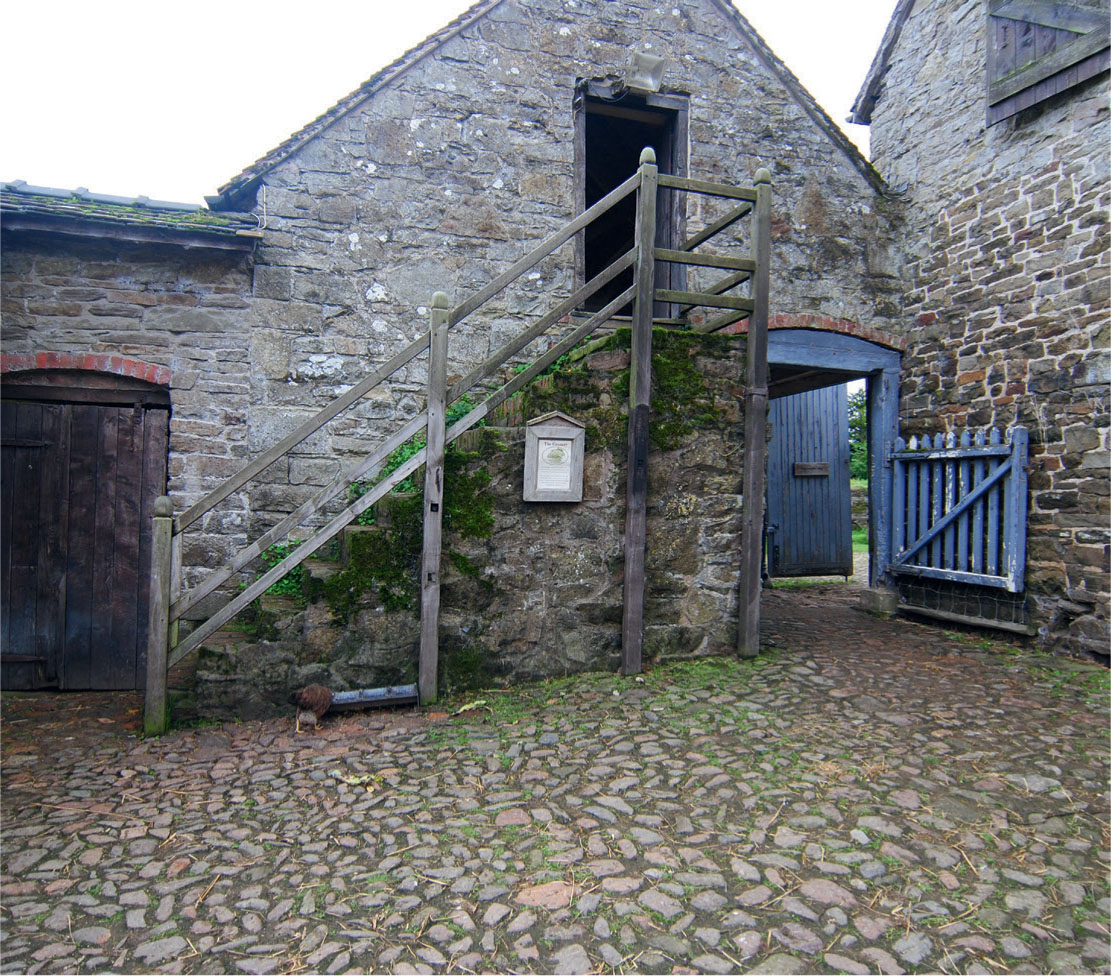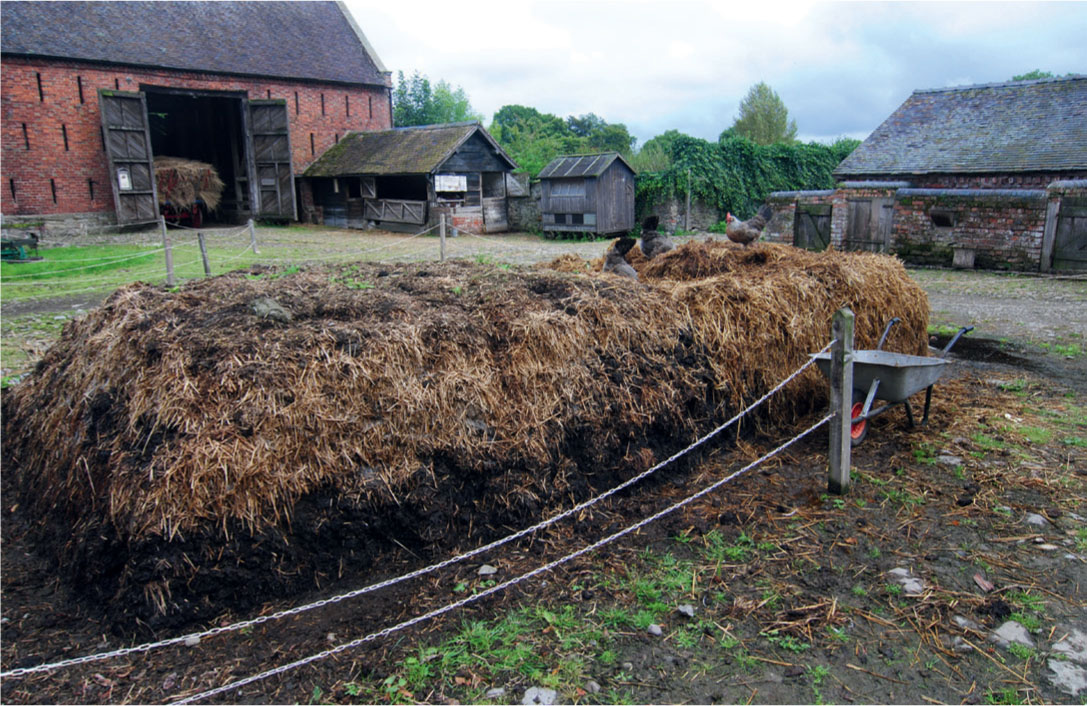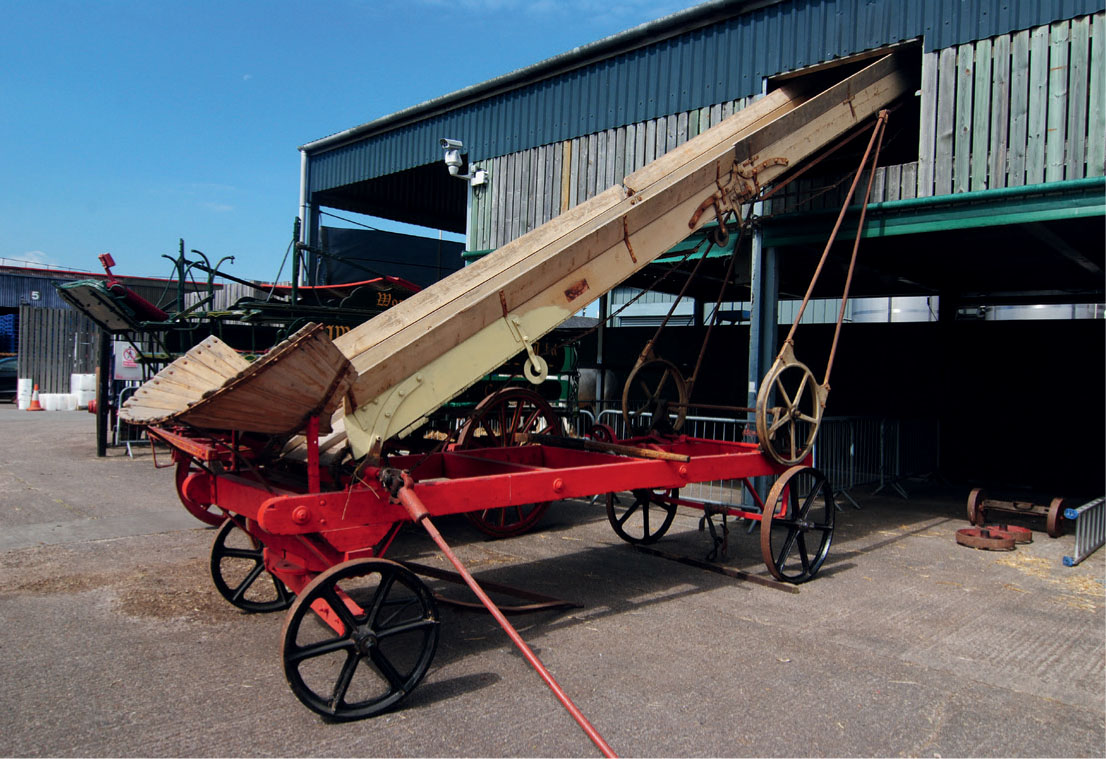This design for Birchcombe Farm was drawn before starting on its construction.
DOWN ON THE FARM
Any walk along country lanes will take us past a number of farms, so as modellers we should consider how a farm might feature as part of a model railway or even become the whole subject for a diorama. Working the land by growing crops or rearing livestock is the oldest of rural industries. Man has always needed food to survive, initially through hunting and foraging, but the establishment of permanent settlements led to more structured exploitation of the immediate landscape.
The rural farms seen today developed from homesteads that also provided shelter for livestock. In the later Middle Ages these began to be replaced by groups of buildings with dedicated structures for the storage of crops. The livestock were now moved away from the family’s living quarters. Most rural farms have changed little over recent centuries, but farming machinery, methods and equipment have been transformed by advances in technology.
For this book I want to look at a farm from a period starting in the late 1800s through to 1930, which is arguably the most attractive period to model. I have therefore chosen to describe the use of the buildings, together with the associated machinery and equipment, at Acton Scott Historic Working Farm in Shropshire. This discussion will also cover the livestock kept and explain how the farm’s features will provide inspiration for a model.
Home Farm was one of three farms on the Acton Scott estate. It may be thought of as a model farm of a type that would have been repeated all over the country. The farm was also the setting for the six-part BBC2 series Victorian Farm (2009) and its three-part sequel Victorian Farm Christmas, shown later that year. If you are unable to visit Acton Scott, or wish to refresh your memories, these programmes are all available on DVD.
FARM BUILDINGS
At Home Farm, and the many farms like it, the buildings are arranged around a yard: the farmhouse, the main threshing barn, hay barn, dairy, cattle sheds, pigsty, stables, cart and wagon sheds, and the dovecote. Some of the larger model farms would also have had workshops for a blacksmith, farrier and wheelwright on site. Farms that specialized in the production and preparation of fruit or particular crops would have dedicated buildings for these activities. Many Kentish farms, for example, featured distinctive buildings known as oast houses containing special round kilns for drying hops.
The farmhouse
Before we look at a few models, let’s examine the buildings in a little more detail, starting with the farmhouse. This was basically the home for the farmer and his family; farm labourers would have lived in cottages around the estate but not within the farm. The farmer’s wife would have been kept busy with domestic chores and running parts of the farm.
Farmhouses, therefore, contained only the basic accommodation for the family. The kitchen was the main room of the building and where the family would congregate. The farmer and his family would not benefit from the conveniences or luxuries enjoyed in modern homes today: life on the farm was hard, starting in the early hours and not finishing until late in the evening.
The barn
The main building in a farmyard, and its most enduring symbol, was the barn. The threshing barn was an important element of farm life, coming into use when the harvest was brought in during late summer. The corn was stored in two bays, above and to the side of the threshing floor. Threshing was originally done by beating the corn with a flail, but this process was later mechanized.

The finished model of Birchcombe Farm was constructed from card for my 4mm layout ‘Tawcombe’. Das modelling clay was scribed and painted to represent rubble stone. DAVE RICHARDS

The Yorkshire Dales farmyard has been dressed with such details as the farmer harnessing the horse, his wife feeding the hens, and a dog looking on. DAVE RICHARDS

A farm hand is here seen clearing the yard outside the threshing barn. DAVE RICHARDS

The stone hay barn at Acton Scott Home Farm. The cobbled surface of the farmyard in front of the barn provides good reference material for the model maker.
The threshing barn would also feature two large sets of doors positioned either side of the building, allowing wagons to be brought into the barn for unloading through one set and then leave through the other. When the process of threshing was underway, a board was placed on the floor across the width of the open doors to stop the grain from spilling out. This is the origin of the term ‘Crossing the threshold’.
Other barns found in the farmyard were built to store and dry the hay for animal feed over the winter. The hay barns had an upper floor or loft where the hay was laid out to dry. The outside of the barn featured a set of steps to gain access to the hayloft. The loft would have a door positioned along the wall from where the hay could be dropped into waiting wagons below. Hay barns built outside the farmyard were known as field barns.

A muck heap is a feature of any working farm. The threshing barn is seen across the yard, together with the pigsty.
The dairy
The larger estate farms would have a dairy provided with adequate drainage and ventilation. The same building would usually contain a milking shed. An important requirement was a nearby supply of clean water. If possible the building was sited away from the farmyard on the north side of the farmhouse, where powerful smells were less likely to taint the produce. One of the activities carried out in the dairy would be turning cream into butter by spinning it in a churn.
Cattle sheds
Sheds where cattle could be held on site before taking them for milking were situated alongside or near the dairy. These would be similar to a stable. Mangers were fitted to inside walls to hold hay and other cattle feeds.
Pigsties
These consisted of a simple stone or brick-built shelter with an entrance door made a little wider and taller than the largest pig. In front of this squat structure was a walled pen fitted with a door or gateway to gain entry to the pen. Most pigsties comprised a series of shelters, together with their adjoining pounds. Pigs kept on the farm were often local breeds selected for the variety of meats they provided.
Stables
Every farm would require a number of heavy horses that carried out most of the hard work. The horses would need to be well looked after if they were to perform regular service on the farm. They were housed in a stable block that offered good-quality accommodation with a cobbled or flagstone floor, and a wooden stall provided for each horse fitted with a manger that offered a constant supply of hay. Adjoining the stables would be the harness room, which supplied all the harness gear needed for the varied jobs on the farm.
The cart shed
The farmyard would also need accommodation for the many carts and wagons used on the farm. To keep these in regular service they would need shelter when not in use. The shed might be built from various materials, with timber the most common. The building would have a substantial roof covered with tiles or slates. The front would be left open with the roof supported on timber or brick pillars. These would create multiple bays for each wagon or cart to be parked inside under cover.
Dovecotes
Another feature of the larger estate farmyard would be housing for the pigeons that provided eggs and an extra meat source. To house the pigeons a special tall structure was built that was typically square or round in shape. Numerous recesses were set into the walls for the pigeons to nest. A ladder was provided inside the building; in the round buildings this was made to rotate from a central beam. It was also common for square recesses for the pigeons to be set into the end walls of the barns or other buildings around the farmyard.
Hen houses
Poultry would be kept within the farmyard for supplying both meat and eggs. These were kept in wooden hen houses, providing special accommodation for the birds and compartments to collect the eggs. A pen was provided in front to offer the poultry plenty of room for exercise, together with provision for food and water.
On an estate farm the yard itself would be cobbled. At the centre of the yard it was common to find a muck heap to take all the waste products generated by the farm, including the livestock. This was an essential resource for providing manure to fertilize the crops grown in the fields.
MODELLING THE FARM
Numerous items of interest are available on the market either in kit form or as ready- to-plant models. Starting with kits, a few barns are available in card from Metcalfe Models, including a tall stone-built threshing barn and a modern prefabricated steel-framed barn. Metcalf Models also supply card model kits of the farmhouse and a modern cart and tractor shed.
The attractive set of farm buildings available from the Townstreet range is well produced from reconstituted stone powder, which provides the relief and texture of stone buildings. The small barn offered in the Wills range of plastic kits comes with a collection of farm equipment and junk.
The ready-to-plant options include the farm buildings available in the Scenecraft by Bachmann range, such as a timber barn and a modern pre-cast concrete cowshed. There is also a barrel-roofed Dutch barn, complete with stacked bales of hay. The Hornby Skaledale range of farm buildings includes a country farm outhouse, together with a tractor and plough shed, and a Dutch barn.
Farms make a good subject for a scratch-building project, offering some interesting challenges. In recent years I have taken much pleasure in modelling whole farmyards, both for commissions and as a feature on my Devon-based model railway. I have also completed models of barns and other individual farm buildings.
All of these models have been built from card or foamboard shells with Das added for the masonry. The roofs were mainly made from card, although I have also attempted a few thatched roofs, using the materials and techniques discussed in the project for a small timber field barn in Chapter 3.
DRESSING THE MODEL FARM
Plenty of options are available to provide dressings that will bring a model farm to life. These include all the animals and other livestock. together with equipment, farm machinery, wagons, carts and the farm staff. Since farms are such a popular subject, the model market has provided plenty to choose from in all scales, with items available in plastic, resin, brass or white metal castings.

Every farm needs a few carts and wagons, such as the well-used tip cart seen here.

Out in the fields, one of the farm horses is harnessed to a tip cart while it is being loaded. Reference material like this is valuable when dressing rural models.

A hay elevator, such as this example at the National Brewery Centre, Burton upon Trent, made the job of loading the hay to the loft of the barn much easier.
In 7mm scale kits from both S&D Models and Duncan Models offer a wide variety of vehicles and wagons, including haywains and drays. They both supply very fine kits of farm tip carts, as well as the heavy horses required to pull them. Both suppliers offer a good selection of farm machinery, including vintage tractors, ploughing engines, stationary steam engines, threshing machines, hay elevators, shepherds’ huts, ploughs, rakes and many other tools and smaller machinery.
Besides the vehicles and machinery, S&D Models, Duncan Models and Invertrain Model Railways supply a good range of farm animals and livestock. They also offer some very well-sculpted figures of farm labourers, milkmaids, shepherds, carters, ploughmen, farriers and blacksmiths.
Farm vehicles, machinery, livestock and farm staff are well covered in 4mm scale. Dart Castings produce a comprehensive range of white metal castings, including numerous kits related to farms and farming. There are more available in this scale, as well as 2mm scale, from the Shire Scenes brass etched kits range, which is now part of Dart Castings.
Many examples of farm vehicles, farm machinery, livestock and figures are included in the massive range of kits from Langley Miniature Models. Besides white metal castings and brass, there are also plastic moulded farm animals by Peco, which come pre-painted. All these sets are available in both 4mm and 2mm scales, with good detail reproduced from the moulds. Also available in plastic is the forty-three piece Farm Stock set first offered by Airfix in 1960. These are very good for their age, although, unlike the ones from Peco, they will need painting.

Steam ploughing engines, each fitted with a winding drum, were used in pairs placed either side of the field. The plough, with the seated ploughman, was attached to a cable by which it was pulled backwards and forwards across the field, creating perfectly cut furrows. This would make a great feature to add to any rural model scene.

Tractors were introduced to farms in the 1920s and gradually replaced horses for most working duties on the farm.
We can now choose a farm to model, confident that all these dressings are instantly available in most of the popular scales. It is also worth remembering that advances in technology can bring the possibility of adding all the sounds of the farm too.